Theory and Analysis:Sequel Theory Counter-Evidence
"Sequel Theory" is the enduringly popular idea that the Rebuild of Evangelion films are not a separate continuity, but are instead a follow-up in a more than spiritual sense. In its most basic form, this idea posits that the films occur on Earth after the Third Impact of End of Evangelion; exact specifics as to how this is supposed to work vary. In its multitudinous more convoluted forms, it would be more accurately described as "Cycle Theory", with NGE and NTE both being iterations of a cycling universe. This article will not deal with the latter, since said variation isn't really concrete enough to be debated, and instead concentrate on most of the supposed evidence associated with the idea of Rebuild being a slightly more literal sequel.
Second Impact... or Third?
As soon as fans sat down in Japanese theaters to see Evangelion 1.0, the idea that they were being shown some kind of continuation took seed[1]. Since the film was a retelling of the TV series' first six episodes with only minor storytelling variations, why would anyone think it somehow took place after EoE? Before anything can be debunked, we must first look at what's believed in the first place and why, so... shall we?
Blood in the Water
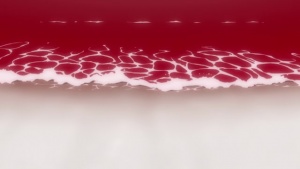 |
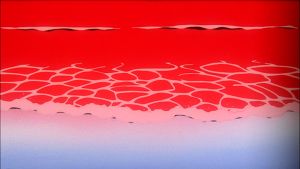 |
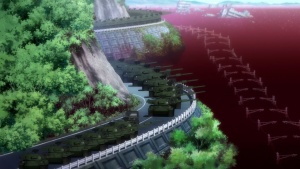 |
 |
We see here that the first shot is a direct callback to EoE's final scene, and the otherwise familiar sights of Episode 01 have been transformed by an ocean that is no longer blue, but blood-red. With brutally efficient use of visuals, the end of the previous Eva sage has been linked to this new one. But why...?
The Mysterious Outline
Amidst the opening montage of images -- the storyboards taken nearly verbatim from Episode 01 -- showing the lingering damage from Second Impact, something new appears...
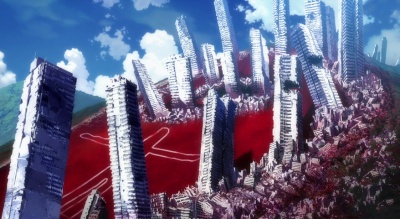 |
This appears to be the bold white outline of a giant humanoid in cruciform position, painted over a blood-stained hillside littered with damaged buildings. For many NGE veterans, the visual immediately recalls the dead Mass Production Evangelions from EoE, on account of the general profile and especially the long slender region where a head and neck would be:
| End of Evangelion: Crucified Eva Series | |
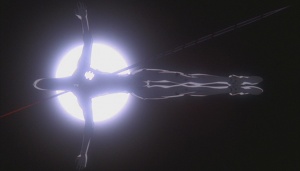 |
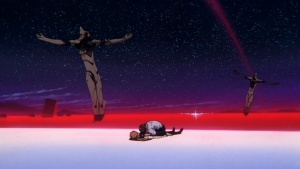 |
The outline in 1.0 is more strongly reminiscent of the MP Evas before they petrify and, off-screen, spontaneously undergo decapitation -- but even once this happens the conical entry plug hatches still extend their outlines in approximately the same way.
Blood on the Moon
The final scene of the film takes us to Mare Tranquilitatis[2] of the moon, where we can see a long, thin streak of blood-colored fluid soaked into the turf:
| Evangelion 1.0: Blood on the Moon | |
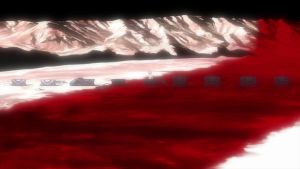 |
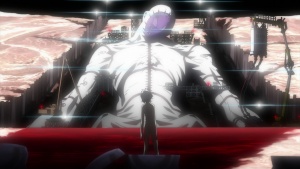 |
...which, again, recalls the way NGE ended, rather than how it began:
| End of Evangelion: Blood Flies to the Moon | |
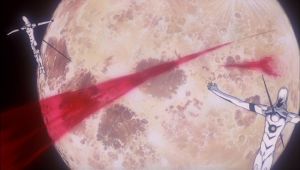 |
 |
Kaworu remembers?
Audiences at the time that Eva 1.0 came out, and many even to this day[4], see these visuals and immediately, viscerally interpret them as hints that the film occurs on the same planet Earth on which Neon Genesis Evangelion occurred, in the wake of the post-EoE timeline somehow being partly "reset" to starting conditions. While there is no generally accepted reason for why this would have happened in the first place, the blood-red oceans, the outline resembling an MP Eva, and the blood on the moon are all pointed to as clear holdovers from the world before the reset. And then there is this, the sole dialogue from the final scene[5]:
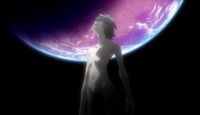
| “ |
KAWORU: I know. The boy down there's awakened, and we've entered the general stage of the plan, correct? KEEL: That's correct. The Dead Sea Scroll Apocrypha have been fulfilled up to the Book of Law. The hour of our covenant draws near. KAWORU: The Third again, huh? You sure haven't changed. I look forward to seeing you, Ikari Shinji-kun. |
„ |
Here, Kaworu expresses familiarity with Shinji (the Third Boy), while also saying that he looks forward to seeing (or meeting) him. Sequel theory interprets this to mean that Kaworu is yet another holdover from the previous iteration: he knows Shinji from the events of Neon Genesis Evangelion, but has not yet met him in New Theatrical.
As Kaworu's seeming foreknowledge of Shinji remains an aspect of the film series that has not yet been explained, there will be no attempt to address it here. However, we can explore the three other points, since the three released Rebuild films, along with the available supplemental sources, provide sufficient data to reach a fairly solid understanding of what's really going on.
No, It Really is the Second
Regardless of whatever is going on with Kaworu, the remaining "big three" -- which have been and continue to be rolled out in Internet posts, ready-to-go infographics, and YouTube videos time and time again -- can, with the careful observation that Eva has always demanded of its audience, be shown to have absolutely nothing to do with the Third Impact that occurred in End of Evangelion. We'll start with the simple and concrete, and work our way up to the more convoluted and weird.
The Moons Don't Match
While both moons have blood-red stains on them, the stains themselves are completely different. This is an observation that can be made as early as Eva 1.0, requiring no clarification from later installments.
The film transitions to the final scene on the moon by first panning up from the aftermath of Operation Yashima to the night sky, where a full moon brilliantly glows. This shot provides a complete glimpse of the side of the moon facing earth. According to Explanation of Evangelion 1.01, the final scene takes place at the 7th Branch of Nerv (to be later known as Tabgha Base) within Mare Tranquilitis. This places it somewhere in the dark blotch in the upper right region of the lunar image provided. (And even without knowing this tidbit, the base can be readily deduced as being on the Earth-side of the moon, since the planet is visible behind Kaworu, showing the very bottom of Australia.)
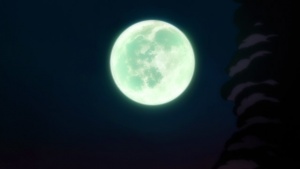 |
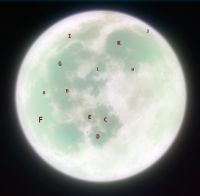 |
 |
As we can see, the near side of the Moon shows no traces of staining that are visible from space, very much unlike the blood stain from EoE. This rules out any possibility of the two stains being the result of the same event. The one in the New Theatrical films was caused by something completely unique to this version of the story. And, yes, the films offer plenty of hints as to what that thing might be. Let's take a look.
Blood Floods
NGE's Second Impact acts as an allusion to the Great Flood of the Bible... divine punishment enacted against a sinful human race. NTE builds upon that framework with zeal and little regard for excess, showing us a post-Second Impact world even more hellish than that depicted in the original series, and then on top of that having every Angel battle end with another miniature flood of blood to echo the big one. While the Great Flood of NGE's Second Impact was caused by the catastrophic explosion of Adam, resulting in the near-instantaneous melting of the Antarctic ice cap, these "mini-floods" in NTE have a much different cause.
MORE TO COME -Reichu, 7/2017--
References
- ↑ Anonymous spoiler posted to /a/ and cross-posted to EvaGeeks Forums, 2007/09/01.
- ↑ Explanation of Evangelion 1.01.
- ↑ Paraphrased from the storyboard's description for Cut 386
- ↑ Summer 2017, at the time of this article's original penning.
- ↑ Evangelion 1.11, custom Reichu translation combining aspects of those done by Lolfang & Reito and Funimation with my own tweaks.
